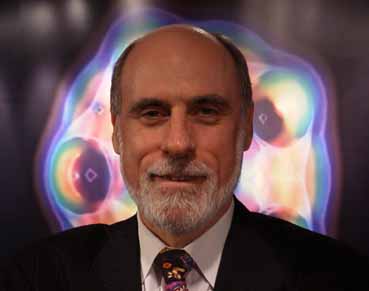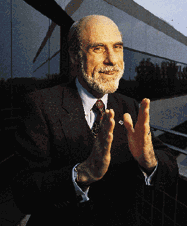Note from the author: Various audio clips appear
here and throughout of Vint Cerf. The interview was conducted on March
1, 2000, at the Access facility of the National Science Foundation
in Washington, D.C. Expenses were provided by the Park Foundation.
As
a graduate student at UCLA, Vint Cerf was involved in the early design
of the ARPANET. He was present when the first IMP was delivered to
UCLA. He is called the "father of the Internet." He earned this nickname
 as
one of the co-authors of TCP/IP-the protocol that allowed ARPA to
connect various independent networks together to form one large network
of networks-the Internet.
as
one of the co-authors of TCP/IP-the protocol that allowed ARPA to
connect various independent networks together to form one large network
of networks-the Internet.
A
Young Man with Style
Cerf grew up in Los Angeles. He did very well in school and showed
a strong aptitude for math. He had an unusual style of dress for a
school kid. He wore a jacket and tie most days. Cerf is still known
for his impeccable style. He is usually seen in three-piece suits.
As
a child, Cerf began to develop an interest in computers. He attended
Stanford and majored in mathematics, but continued to grow more interested
in computing. "There was something amazingly enticing about programming,"
said Cerf. "You created your own universe and you were master of it.
The computer would do anything you programmed it to do. It was this
unbelievable sandbox in which every grain of sand was under your control."
(Cerf in Hafner & Lyon, 139).
When
Cerf graduated from Stanford in 1965, he went to work for IBM as a
systems engineer, but soon decided to return to school to learn more
about computers. He enrolled in UCLA's computer science department
and began pursuing his Ph.D. His thesis was based on work he did on
an ARPA-funded project for the "Snuper Computer"—a computer that was
designed to remotely observe the execution of programs on another
computer.
An
Interest in Networking
The
Snuper Computer project got Cerf interested in the field of computer
networking. In the fall of 1968, ARPA set up another program at UCLA
in  anticipation
of building the ARPANET. It was called the Network Measurement Center.
It was responsible for performance testing and analysis, a sort of
testing ground. A man named Len Kleinrock managed about forty students
who ran the center. Cerf was one of the senior members of the team.
anticipation
of building the ARPANET. It was called the Network Measurement Center.
It was responsible for performance testing and analysis, a sort of
testing ground. A man named Len Kleinrock managed about forty students
who ran the center. Cerf was one of the senior members of the team.
By
the end of 1968, a small group of graduate students from the four
schools that were slated to be the first four nodes on the ARPANET
(UCLA, Stanford, the University of Utah, and UC Santa Barbara) began
meeting regularly to discuss the new network and problems related
to its development. They called themselves the Network Working Group
(NWG). The NWG proved to be instrumental in solving many of the problems
that would arrive during the design and implementation of the ARPANET,
but they did not realize their importance at the time. Cerf recalls,
"We were just rank amateurs, and we were expecting that some authority
would finally come along and say, 'Here's how we are going to do it.'
And nobody ever came along." (Cerf
in Abbate, 73)
Protocols
One
of the main obstacles facing the deployment of ARPA's network was
the problem of getting incompatible host computers to communicate
with one another through the IMPs. Bolt Beranek &Newman (BBN) was
only responsible for building the IMPs and making sure they could
move packets, not devising the methods they and the host computers
would use to communicate. Devising standards for communication, what
came to be known as a protocol, became one of the NWG's main tasks.
The
NWG implemented a "layered" approach in building a protocol. This
means that they created several simple "building block" protocols
that could later be joined to oversee network communication as a whole.
In 1970, the group released the protocol for basic host-to-host communication
called the Network Control Protocol (NCP). They also created several
other protocols to work on top of NCP such as Telnet, which allowed
for remote logins.
 Vint
Cerf discusses obstacles in ARPANET development.
Vint
Cerf discusses obstacles in ARPANET development.
A
True Internet
In
August 1969, BBN delivered the first IMP to UCLA. A month later The
second was delivered to SRI. The ARPANET continued to grow quickly
from that point. Cerf was present when the first IMP was delivered
to UCLA. He was involved with the IMP immediately performing various
tests on the new hardware. It was during this testing that he met
Bob Kahn. They enjoyed a good working relationship.
 Vint Cerf talks about the delivery of the first IMP to UCLA.
Vint Cerf talks about the delivery of the first IMP to UCLA.
 Vint Cerf talks about Bob Kahn.
Vint Cerf talks about Bob Kahn.
Within
a few years of the creation of the ARPANET, other computers networks
were deployed. They were all independent  self-contained
networks. Cerf recalls, "Around this time Bob started saying , 'Look,
my problem is how I get a computer that's on a satellite and a computer
on a radio net and a computer on ARPANET to communicate uniformly
with each other without realizing what's going on in between?'"(Cerf
in Hafner & Lyon, 235).
self-contained
networks. Cerf recalls, "Around this time Bob started saying , 'Look,
my problem is how I get a computer that's on a satellite and a computer
on a radio net and a computer on ARPANET to communicate uniformly
with each other without realizing what's going on in between?'"(Cerf
in Hafner & Lyon, 235).
They
decided that there needed to be a "gateway" computer between each
network to route packets. The gateway computers would not care about
the various complexities of each network. They would simply be in
charge of passing packets back and forth. But all of the networks
transmitted packets in different ways, using their own protocols.
A new standard was needed to link all of the networks and allow inter-network
communication.
Cerf
and Kahn began working out a plan in 1973. In September, they presented
a paper outlining their ideas to the International Networking Group.
In May 1974, they complete their paper entitled, "A Protocol for Packet
Network Intercommunication." They described a new protocol they called
the transmission-control protocol (TCP). The main idea was to enclose
packets in "datagrams." These datagrams were to act something like
envelopes containing letters. The content and format of the letter
is not important for its delivery. The information on the envelope
is standardized to facilitate delivery. Gateway computers would simply
read only the delivery information contained in the datagrams and
deliver the contents to host computers. Only the host computers would
actually "open" the envelope and read the actual contents of the packet.
TCP allowed networks to be joined into a network of networks, or what
we now call the Internet.
Cerf
continued to refine TCP. In 1976, he accepted a job as program manager
responsible for what was then called the "ARPA Internet" at ARPA.
In 1978, Cerf and several of his colleagues made a major refinement
in 1978. They split TCP into two parts. They took the part of TCP
that is responsible for routing packages and formed a separate protocol
called the Internet Protocol (IP).TCP would remain responsible for
dividing messages into datagrams, reassembling messages, detecting
errors, putting packets in the right order, and resending lost packets.
The new protocol was called TCP/IP. It went on to become the standard
for all Internet communication.
 Vint
Cerf talks about problems facing the early Internet..
Vint
Cerf talks about problems facing the early Internet..
 What
would Cerf change about the Internet?
What
would Cerf change about the Internet?
 Cerf
talks about security problems
Cerf
talks about security problems
New
Horizons
Today
Cerf is the chief
Internet strategist for MCI WorldCom. His latest pet project is
called the
Interplanetary Network (IPN). This project, part of NASA's Jet
Propulsion Lab, will basically extend the Internet into outer space.
It's fitting that the "father of the Internet" on Earth should be
involved in launching it to new worlds.
 Vint
Cerf talks about the Interplanetary Network.
Vint
Cerf talks about the Interplanetary Network.

Home|
Vannevar Bush | J.C.R.
Licklider | Larry Roberts | Paul
Baran |
Bob Metcalfe |
Doug Engelbart | Vint Cerf | Ted
Nelson | Tim Berners-Lee | Marc
Andreesen | Epilogue |
References |